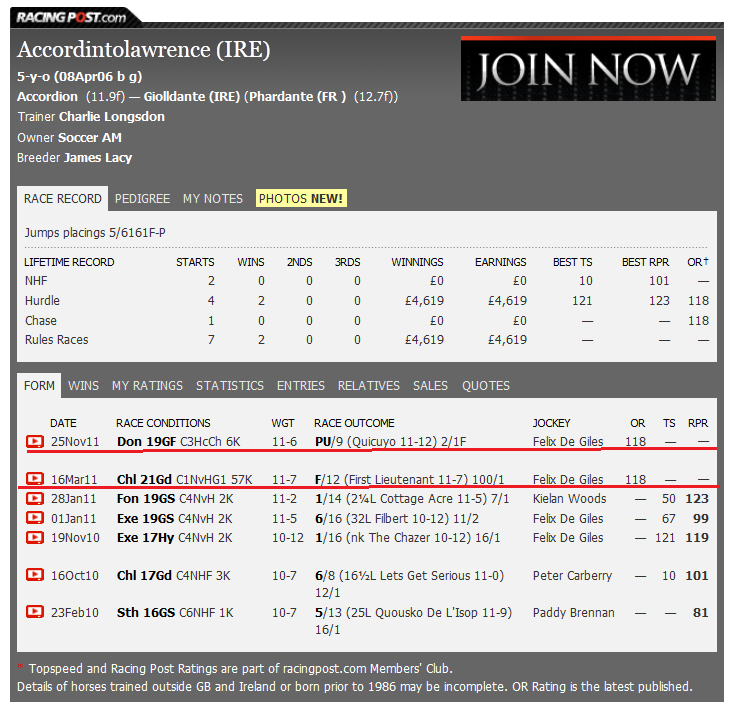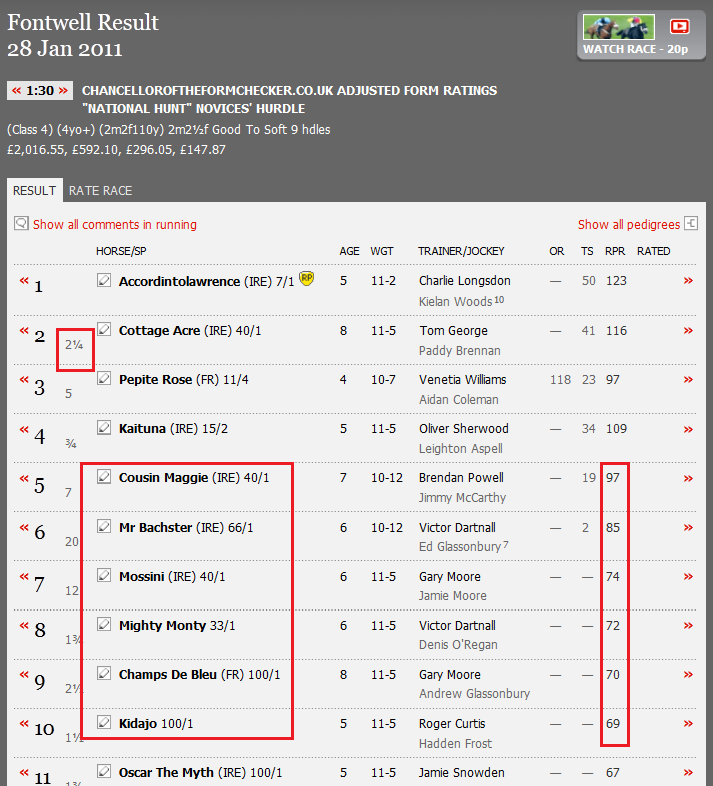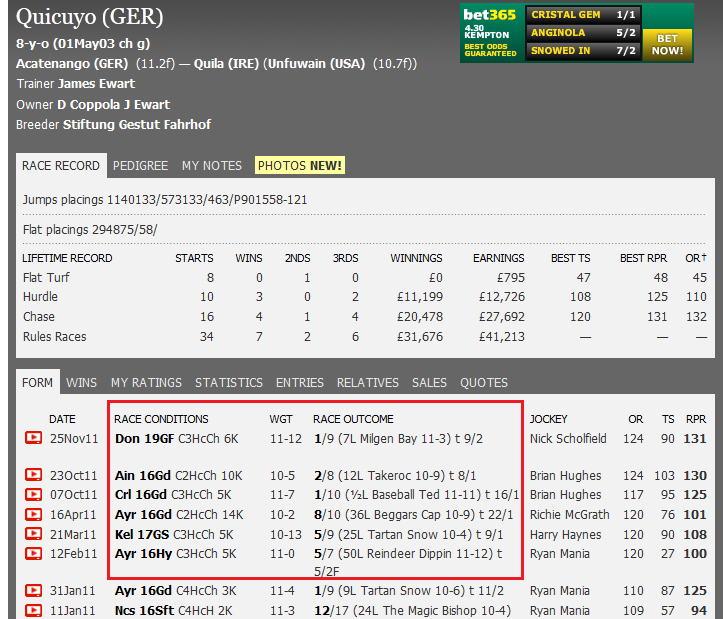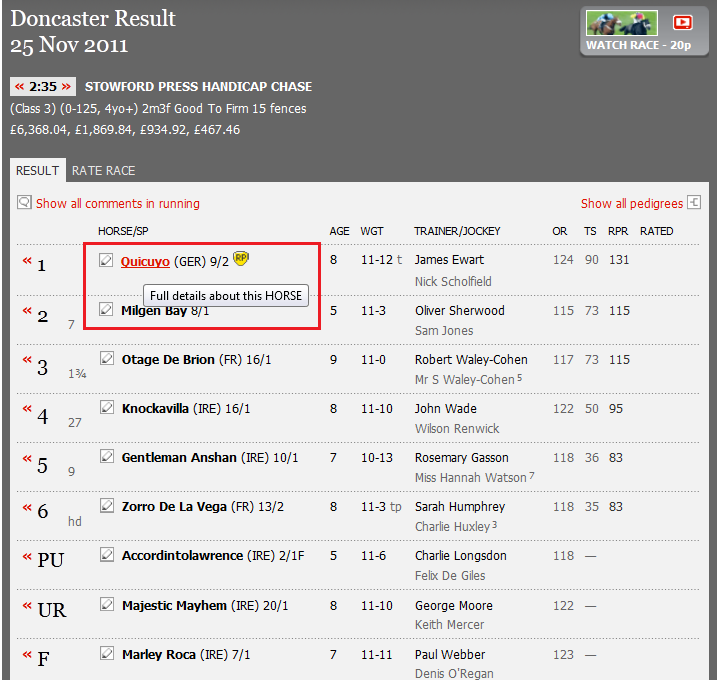Revealed-Why You Shouldn`t Lay Favourites Until Youv`e Followed These 3 Important Steps
December 1, 2011 by Jonathan
Filed under Horse Racing, Recent Articles
Before considering laying the favourite in a race you must first assess what the opposition looks like. It is no use identifying a few negatives only to find that its main rivals aren’t up to much either. Any potential lay bet must face at the very least, two other horses that have comparable, or superior form and ability.
In our last blog post why outclassed horses make great lays we looked at what effect a change in class could have on a horses chances. In this tutorial we will look at how to assess the level of competition favourites face, and how that will affect their chances of winning.
Once you have identified a particular favourite’s weaknesses you must then determine the ability of its main rivals, to see if you can find other horses which have achieved comparable levels of form in their races, to that of the favourite.
If you do spot one or two which have more positives than the favourite, then this will strengthen your decision to lay the favourite. However, if you can’t find any positives for other horses then this would probably be a race not to bet in? The key question is…
Are there any horses that can beat the favourite?
What to look for
If the favourite won by three or four lengths in a class 3 event then you need to find other horse who also won or placed in a class 3 event. It’s no use if the favourites closest rival won a class 4 or class 5 by a short head because…
A) The horse won a weaker race compared to the one the favourite won, and B) It only just won by a short head, which indicates that the horse should not be considered particularly strong opposition to the favourite, judging by how close the runner up in its previous race was to it.
Assess the quality of opposition the favourite beat last time out
In order to compare to the level of opposition the favourite faces in its current race compared to its last race you need to pay attention to 4 key areas:
4 step Form comparison checklist
1. Did the favourite beat previous winners? If so what level of class and ability did they have? The form should be considered reliable if the favourite beat horses of the same class on equal terms. Conversely, if the favourite beat a field of out of form rivals, or lower class horses, then the form should be treated with caution.
2. Horses that won their respective races because another horse fell at the last hurdle or fence only won by default.
3. If the favourite has never won a race before, but been placed second or third, you should then look for other horses that have also placed in comparable races of similar class.
4. Assess Winning margins. Identify HOW the horse won, was it by a short head or did it trounce the opposition by 20 lengths?
Gaining a big advantage through results analysis
Results should be considered a layers best friend. Simply because a post-mortem style assessment can be performed, to establish why a particular favourite was beaten.
The example below shows the race history of Accordingtolawrence. This horse had been stepped up in grade since its last win on 28 January 2011. Both attempts to compete in class 1 and class 3 races failed, yet in its most recent race (25 Nov 2011) this horse went off a 2/1 favourite in a class 3 race. In our opinion it’s race history clearly showed that it had a class barrier and therefore was a false favourite
Follow these simple steps to assess what type of opposition a horse beat in its last winning race, or last time out using the Racingpost.
STEP 1. Race History
Click on a horses name anywhere in the race card. This opens up its race history. Clicking any race in the RACE OUTCOME column opens up the result for that race.
STEP 2. Previous Results
To assess the ability of the horses your potential lay selection beat in its most recent win. Click on the relevant race in the race outcome column (in this example 28th Jan 11 at Fontwell)
The result tells us almost instantly that Accordingtolawrence didn’t really beat anything of quality in its last winning race. How do I know this? Well there are several clues, but the main thing that stands out is the odds of the runners. Betting market efficiency means a horses true chances of success are directly linked to its odds.
With this in mind I considered this a three horse race, with the main contenders being Accordingtolawrenec 7/1, Peptide Rose 11/4, Kaituna 15/2. Everything else ranged from 40/1 to 100/1. This is something we discussed in our tutorial value betting – the secrets of getting better odds than the average punter
Getting back to the example below. Other clues included:
- The collective racing Post ratings of the horses Accordingtolawrence was competing against. Only 3 horses were within 12lbs of the horse (Cottage Acre 116 & Kaituna 109) The rest rated 97-67 – basically low quality opposition.
- The win margin was short at only 2 1/2 lengths. Although the horse won, it was nothing special considering the race was 2 miles 2 furlongs.
STEP 3. Assess the opposition
For the purpose of this tutorial we will only show a screenshot of one of the rivals Accordingtolawrence’s faced in its most recent race, simply to save space. Let’s take a look at “Quicuyo`s” race record and give you a few pointers on how to go about to identifying potentially better class opposition to your lay selections.
Pay close attention to the area highlighted by a red box. In simple terms we are looking at what type races this horse has been competing in and compared those to the favourite – Accordingtolawrence. Quicuyo had been contesting class 2-3 Chases in its last four races. In those four races the horses form reads 2,1,8,5. This represents much better quality form then anything according to Lawrence has achieved, in fact Accordingtolawrence had never won above class 4. This wasn’t the only horse which had comparable, or superior form to the favourite, others included:
- Milga Bay; last 3 races – class 3 chase, pos 2nd – Cl5 chase, pos 1st – class 4 chase, pos 3rd (form slighly better than the favourites)
- Otage De Brion; last 3 races – class 3 chase, pos 3rd- Cl4 chase, pos 3rd – class 3 chase pos 7th (Form at least equal)
- Knockavilla; last four races – class 3 chase, pos 4th – Cl3 chase, pos PUp – class 3 chase, pos 2nd (form slighly better than the favourites)
Ultimately, there were at least four horses in with a winning chance.
You can check out these horses in more detail here. When the results screen opens up, simply click on any of the horses names to assess therefore histories
Summary
You should not lay favourites with a few negatives against them, if their main rivals have as many, or more negatives. Being able to distinguish between the negatives and the non-positives is essential to the success of your lay bet. When you first start out there will be a learning curve. The detailed lay examples included in this book will teach how to find, and oppose weak favourites for profit.
When I first started laying horses I would find what I considered to be weak favourites, and blindly lay them solely based on a couple of negatives. The fact still remained the opposition was pretty poor, and so these animals had to do very little to win their respective races.
With the beauty of hindsight I am able to pass on this wisdom to you through this system, and so my past mistakes become your future profits.
I’m not interested in what tipsters are backing, because I prefer to find my own lay bets. I use the Racingpost as a research tool, because it provides me with facts and opinions on which way the market is likely to bet.
If you’d like to learn more about finding out which races are the best to lay favourites in, and further your betting education then you need this book.
Resources
For more pro-tips tips on form reading, Download our comprehensive betting guides.
And if you’d like to share your experiences and tips on picking selections using any of the following Racing Post, Timeform or Sporting life take the floor and post a comment in the form below. They’re always welcome.
Learn how to make realistic profits from betting
Practical, profitable advise direct to your inbox
- Proven techniques I use in my own betting
- Honest reviews on systems and services that are profitable
- Exclusive tips to make your betting easier & more profitable
 Copyright secured by Digiprove � 2010 Jonathan Burgess
Copyright secured by Digiprove � 2010 Jonathan Burgess
Comments
One Response to “Revealed-Why You Shouldn`t Lay Favourites Until Youv`e Followed These 3 Important Steps”Speak Your Mind
Tell us what you're thinking...and oh, if you want a pic to show with your comment, go get a gravatar!













Great post as always! Definitely has loads of useful information. Thanks so much for sharing!
-Natalie